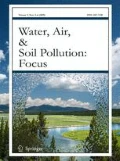Abstract
Different methods exist for measuring soil water and solute fluxes in and below the root zone and have been critically reviewed. Besides indirect methods (e.g. water balance, tensiometer, time domain reflectometry – TDR, frequency domain reflectometry – FDR, environmental tracer) direct methods (e.g. drainage-type lysimeter, water fluxmeter) have a long tradition and have been successfully used in seepage research. A large weighable out door lysimeter is the best method for obtaining reliable data about seepage water quantity and quality, but it involves significant investment and additional expenses for maintenance. To tackle this problem new methods for the vertical collection of large volume soil monoliths (up to 6 m3) as well as for the horizontal collection (up to 6 m3) have been developed. For the placement of the lysimeter a container lysimeter unit was constructed, which is cheaper than a conventional steel or concrete cellar. Furthermore, the technical design of the newly developed lysimeter types as a weighable gravitation lysimeter, a weighable groundwater lysimeter and a lateral flow lysimeter are presented.






Similar content being viewed by others
References
Bethge-Steffens, D., Meissner, R., & Rupp, H. (2004). Development and practical test of a weighable groundwater lysimeter for floodplain sites. Journal of Plant Nutrition Soil Science, 167, 516–524.
Bethge-Steffens, D., Meissner, R., & Rupp, H. (2005). Quantifizierung des Bodenwasserhaushaltes mit Hilfe eines neu entwickelten wägbaren Grundwasserlysimeters. Wasserwirtschaft, 95, 37–40.
Derby, N. E., Knighton, R. E., & Montgomery, B. R. (2002). Construction and performance of large soil core lysimeters. Soil Science Society of America Journal, 66, 1446–1453.
DVWK (1980). Empfehlungen zum Bau und Betrieb von Lysimetern. Bonn: Deutscher Verband für Wasserwirtschaft und Kulturbau Nr. 114.
Edwards, W. M., Riess, F., Banta, J. W., Shipital, M. J., & Owens, L. B. (1997). Coshocton lysimeter shows importance to sustained production. (Paper presented at the 7th Lysimeter conference, Raumberg-Gumpenstein, Austria, April 1997).
Flury, M., Yates, M. V., & Jury, W. A. (1999). Numerical analysis of the effect of the lower boundary condition on solute transport in lysimeters. Soil Science Society of America Journal, 63, 1493–1499.
Fuehr, F., Hance, R. J., Plimmer, J. R., & Nelson, J. O. (Eds.) (1997). The lysimeter concept. Washington, DC: ACS Symposium Series 699.
Gee, G. W., Ward, A. L., Caldwell, T. G., & Ritter, J. C. (2002). A vadose zone water fluxmeter with divergence control. Water Resources Research, 38, 16.1–16.7.
Gee, G. W., Zhang, Z. F., & Ward, A. L. (2003). A modifed vadose-zone fluxmeter with solution collection capability. Vadose Zone Journal, 2, 627–632.
Hantschel, R. (1993). Neubau einer Lysimeteranlage am GSF-Forschungszentrum für Umwelt und Gesundheit. Mitteilungen der Deutschen Bodenkundlichen Gesellschaft, 71, 135–138.
Haygarth, P. M., & Jarvis, S. C. (Eds.) (2002). Agriculture, hydrology and water quality. New York: CAB International.
Klotz, D., & Seiler, P. (1998). Die GSF-Lysimeteranlage Neuherberg. Muenchen: GSF-Bericht Nr. 23.
Krenn, A. (2002). Lysimeterexperimente – seitliche Randeffekte und deren Wirkung am Beispiel der Lysimeteranlage Seibersdorf. Dissertation, Universitaet fuer Bodenkultur, Wien.
Lanthaler, C., & Fank, J. (2005). Lysimeter stations and soil hydrology measuring sites in Europe – Results of a 2004 survey. (Paper presented at the 11th Lysimeter conference, Raumberg-Gumpenstein, Austria, April 2005.)
Meissner, R., Rupp, H., & Leinweber, P. (2003). Re-wetting of fen soils and changes in water quality – Experimental results and further research needs. Journal of Water and Land Development, 7, 75–91.
Meissner, R., Rupp, H., & Schubert, M. (2000a). Novel lysimeter techniques – A basis for improved investigation of water, gas and solute transport in soils. Journal of Plant Nutrition and Soil Science, 163, 603–607.
Meissner, R., Rupp, H., Seyfarth, M., & Bräutigam, R. (2002). Lysimeter station. European Patent EP 1,153,293, 14 August 2002.
Meissner, R., Rupp, H., Seyfarth, M., & Punzel, J. (2000b). Verfahren zum automatischen Betrieb eines wägbaren Grundwasserlysimeters. German Patent DE 199,07,462, 21 June 2000.
Meissner, R., Seeger, J., Rupp, H., Seyfarth, M., & Borg, H. (2007). Measurement of dew, fog, and rime with a high-precision gravitation lysimeter. Journal of Plant Nutrition and Soil Science, 170, 335–344.
Meissner, R., & Seyfarth, M. (2004). Measuring water and solute balance with new lysimeter techniques. (Paper presented at the 3th Australian and New Zealand Soil Science Conference, Sydney, December 2004.)
Meissner, R., Seyfarth, M., Friedrich, H., Rupp, H., Beuter, M., & Kessler, K. (2005). Vorrichtung zur monolithischen Entnahme von Bodensäulen. German Patent DE 100,48,089,6, 8 July 2005.
Meissner, R., Seyfarth, M., Friedrich, H., Rupp, H., & Seeger, J. (2004). Vorrichtung und Verfahren zur horizontalen monolithischen Entnahme von Bodenkörpern. German Patent DE 103,53,485, 25 November 2004.
Persson, L., & Bergstrom, L. (1991). Drilling method for collection of undisturbed soil monoliths. Soil Science Society of America Journal, 55, 285–287.
Puetz, T., Fuehr, F., & Vereecken, H. (2001). Wägbare Lysimeter mit definierter unterer Randbedingung. (Paper presented at the 9th Lysimeter conference, Raumberg-Gumpenstein, Austria, April 2001).
Puetz, T., Stork, A., & Fuehr, F. (1997). Lysimeter – A comprehensive approach of environmental research. Juelich: Druckschrift Forschungszentrum.
Rupp, H., Meissner, R., & Leinweber, P. (2004). Effects of extensive land use and re-wetting on diffuse phosphorus pollution of fen areas – Results from a case study in the Droemling catchment, Germany. Journal of Plant Nutrition and Soil Science, 167, 408–416.
Schlichting, A. (2004). Phosphorfreisetzung aus wiedervernässten Niedermooren. Dissertation, Universitaet Rostock.
Troxler, J., Zala, M., Natsch, A., Nievergelt, J., Keel, C., & Defago, G. (1998). Transport of a biocontrol pseudomonas fluorescens through 2.5-m deep outdoor lysimeters and survival in the effluent water. Soil Biology and Biochemistry, 30, 621–631.
Tunney, H., Carton, O. T., Brookes, P. C., & Johnston, A. E. (Eds.) (1997). Phosphorus loss from soil to water. New York: CAB International.
Young, M. H., Wierenga, P. J., & Mancino, C. F. (1996). Large weighing lysimeters for water use and deep percolation studies. Soil Science, 161, 491–501.
Author information
Authors and Affiliations
Corresponding author
Rights and permissions
About this article
Cite this article
Meissner, R., Rupp, H. & Seyfarth, M. Advances In Out Door Lysimeter Techniques. Water Air Soil Pollut: Focus 8, 217–225 (2008). https://doi.org/10.1007/s11267-007-9166-2
Received:
Revised:
Accepted:
Published:
Issue Date:
DOI: https://doi.org/10.1007/s11267-007-9166-2




